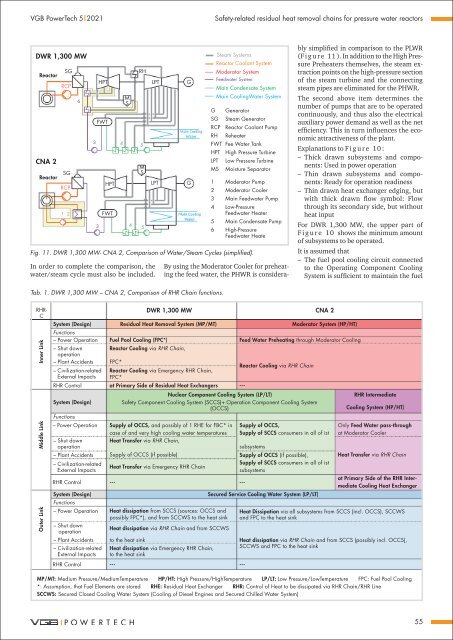VGB POWERTECH 5 (2021) - International Journal for Generation and Storage of Electricity and Heat
VGB PowerTech - International Journal for Generation and Storage of Electricity and Heat. Issue 5 (2021). Technical Journal of the VGB PowerTech Association. Energy is us! Nuclear power. Nuclear power plants - operation and operation experiences
VGB PowerTech - International Journal for Generation and Storage of Electricity and Heat. Issue 5 (2021).
Technical Journal of the VGB PowerTech Association. Energy is us!
Nuclear power. Nuclear power plants - operation and operation experiences
Create successful ePaper yourself
Turn your PDF publications into a flip-book with our unique Google optimized e-Paper software.
Inner Link<br />
Middle Link<br />
Outer Link<br />
<strong>VGB</strong> PowerTech 5 l <strong>2021</strong><br />
Safety-related residual heat removal chains <strong>for</strong> pressure water reactors<br />
DWR 1,300 MW<br />
Reactor<br />
CNA 2<br />
Reactor<br />
SG<br />
RCP<br />
SG<br />
RCP<br />
1 2<br />
6<br />
HPT<br />
FWT<br />
HPT<br />
FWT<br />
RH<br />
In order to complete the comparison, the<br />
water/steam cycle must also be included.<br />
3<br />
3<br />
M<br />
S<br />
4 5<br />
4<br />
M<br />
S<br />
5<br />
LPT<br />
LPT<br />
G<br />
G<br />
Steam Systems<br />
Reactor Coolant System<br />
Moderator System<br />
Feedwater System<br />
Main Condensate System<br />
Main CoolingWater System<br />
G<br />
SG<br />
RCP<br />
RH<br />
FWT<br />
HPT<br />
LPT<br />
MS<br />
1<br />
2<br />
3<br />
4<br />
5<br />
6<br />
Generator<br />
Steam Generator<br />
Reactor Coolant Pump<br />
Reheater<br />
Fee Water Tank<br />
High Pressure Turbine<br />
Low Pressure Turbine<br />
Moisture Separator<br />
Moderator Pump<br />
Moderator Cooler<br />
Main Feedwater Pump<br />
Low-Pressure<br />
Feedwater <strong>Heat</strong>er<br />
Main Condensate Pump<br />
High-Pressure<br />
Feedwater <strong>Heat</strong>e<br />
Fig. 11. DWR 1,300 MW- CNA 2, Comparison <strong>of</strong> Water/Steam Cycles (simplified).<br />
By using the Moderator Cooler <strong>for</strong> preheating<br />
the feed water, the PHWR is considerably<br />
simplified in comparison to the PLWR<br />
(F i g u r e 11 ). In addition to the High Pressure<br />
Preheaters themselves, the steam extraction<br />
points on the high-pressure section<br />
<strong>of</strong> the steam turbine <strong>and</strong> the connecting<br />
steam pipes are eliminated <strong>for</strong> the PHWR.<br />
The second above item determines the<br />
number <strong>of</strong> pumps that are to be operated<br />
continuously, <strong>and</strong> thus also the electrical<br />
auxiliary power dem<strong>and</strong> as well as the net<br />
efficiency. This in turn influences the economic<br />
attractiveness <strong>of</strong> the plant.<br />
Explanations to F i g u r e 10 :<br />
––<br />
Thick drawn subsystems <strong>and</strong> components:<br />
Used in power operation<br />
––<br />
Thin drawn subsystems <strong>and</strong> components:<br />
Ready <strong>for</strong> operation readiness<br />
––<br />
Thin drawn heat exchanger edging, but<br />
with thick drawn flow symbol: Flow<br />
through its secondary side, but without<br />
heat input<br />
For DWR 1,300 MW, the upper part <strong>of</strong><br />
F i g u r e 10 shows the minimum amount<br />
<strong>of</strong> subsystems to be operated.<br />
It is assumed that<br />
––<br />
The fuel pool cooling circuit connected<br />
to the Operating Component Cooling<br />
System is sufficient to maintain the fuel<br />
Tab. 1. DWR 1,300 MW – CNA 2, Comparison <strong>of</strong> RHR Chain functions.<br />
RHR-<br />
C<br />
System (Design)<br />
Functions<br />
– Power Operation<br />
– Shut down<br />
operation<br />
– Plant Accidents<br />
– Civilization-related<br />
External Impacts<br />
RHR Control<br />
System (Design)<br />
Functions<br />
– Power Operation<br />
– Shut down<br />
operation<br />
– Plant Accidents<br />
– Civilization-related<br />
External Impacts<br />
RHR Control<br />
System (Design)<br />
Functions<br />
– Power Operation<br />
– Shut down<br />
operation<br />
– Plant Accidents<br />
– Civilization-related<br />
External Impacts<br />
RHR Control<br />
DWR 1,300 MW CNA 2<br />
Residual <strong>Heat</strong> Removal System (MP/MT)<br />
Fuel Pool Cooling (FPC*)<br />
Reactor Cooling via RHR Chain,<br />
FPC*<br />
Reactor Cooling via Emergency RHR Chain,<br />
FPC*<br />
at Primary Side <strong>of</strong> Residual <strong>Heat</strong> Exchangers<br />
Nuclear Component Cooling System (LP/LT)<br />
Safety Component Cooling System (SCCS)+ Operation Component Cooling System<br />
(OCCS)<br />
Supply <strong>of</strong> OCCS, <strong>and</strong> possibly <strong>of</strong> 1 RHE <strong>for</strong> FBC* in<br />
case <strong>of</strong> <strong>and</strong> very high cooling water temperatures<br />
<strong>Heat</strong> Transfer via RHR Chain,<br />
Supply <strong>of</strong> OCCS (if possible)<br />
<strong>Heat</strong> Transfer via Emergency RHR Chain<br />
---<br />
<strong>Heat</strong> dissipation from SCCS (sources: OCCS <strong>and</strong><br />
possibly FPC*), <strong>and</strong> from SCCWS to the heat sink<br />
<strong>Heat</strong> dissipation via RHR Chain <strong>and</strong> from SCCWS<br />
to the heat sink<br />
<strong>Heat</strong> dissipation via Emergency RHR Chain,<br />
to the heat sink<br />
---<br />
Secured Service Cooling Water System (LP/LT)<br />
Moderator System (HP/HT)<br />
Feed Water Preheating through Moderator Cooling<br />
Reactor Cooling via RHR Chain<br />
---<br />
Supply <strong>of</strong> OCCS,<br />
Supply <strong>of</strong> SCCS consumers in all <strong>of</strong> ist<br />
subsystems<br />
Supply <strong>of</strong> OCCS (if possible),<br />
Supply <strong>of</strong> SCCS consumers in all <strong>of</strong> ist<br />
subsystems<br />
---<br />
RHR Intermediate<br />
Cooling System (HP/HT)<br />
<strong>Heat</strong> Dissipation via all subsystems from SCCS (incl. OCCS), SCCWS<br />
<strong>and</strong> FPC to the heat sink<br />
<strong>Heat</strong> dissipation via RHR Chain <strong>and</strong> from SCCS (possibly incl. OCCS),<br />
SCCWS <strong>and</strong> FPC to the heat sink<br />
---<br />
Only Feed Water pass-through<br />
at Moderator Cooler<br />
<strong>Heat</strong> Transfer via RHR Chain<br />
at Primary Side <strong>of</strong> the RHR Intermediate<br />
Cooling <strong>Heat</strong> Exchanger<br />
MP/MT: Medium Pressure/MediumTemperature HP/HT: High Pressure/HighTemperature LP/LT: Low Pressure/LowTemperature FPC: Fuel Pool Cooling<br />
*: Assumption, that Fuel Elements are stored RHE: Residual <strong>Heat</strong> Exchanger RHR: Control <strong>of</strong> <strong>Heat</strong> to be dissipated via RHR Chain/RHR Line<br />
SCCWS: Secured Closed Cooling Water System (Cooling <strong>of</strong> Diesel Engines <strong>and</strong> Secured Chilled Water System)<br />
55


















